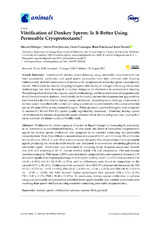Vitrification of Donkey Sperm: Is It Better Using Permeable Cryoprotectants?
Autor
Hidalgo, Manuel
Díaz-Jiménez, María
Consuegra, César
Pereira, Blasa
Dorado, Jesús
Editor
MDPIFecha
2020Materia
DonkeysSperm
Vitrification
Spheres
Sucrose
BSA
Glycerol
METS:
Mostrar el registro METSPREMIS:
Mostrar el registro PREMISMetadatos
Mostrar el registro completo del ítemResumen
Vitrification by direct exposure of sperm to liquid nitrogen is increasing in popularity as an alternative to conventional freezing. In this study, the effect of permeable cryoprotectant agents for donkey sperm vitrification was compared to an extender containing non-permeable cryoprotectants. First, three different concentrations of sucrose (0.1, 0.2, and 0.3 molar, M) and bovine serum albumin, BSA (1, 5, and 10%) were compared. Secondly, the concentration of non-permeable agents producing the most desirable results was compared to an extender containing glycerol as permeable agent. Vitrification was performed by dropping 30 μL of sperm suspension directly into LN2 and warming at 42 °C. Sperm motility (total, TM; and progressive, PM) and plasma membrane integrity, PMI (mean ± SEM) were statistically compared between treatments. Sucrose 0.1 M showed a significantly higher percentage of total sperm motility (21.67 ± 9.22%) than sucrose 0.2 M (14.16 ± 4.50%) and 0.3 M (8.58 ± 6.22%); and no differences were found in comparison to the control (19.71 ± 10.16%). Vitrification with sucrose 0.1 M or BSA 5% obtained similar results for TM (21.67 ± 9.22% vs. 19.93 ± 9.93%), PM (13.42 ± 6.85% vs. 12.54 ± 6.37%) and PMI (40.90 ± 13.51% vs. 37.09 ± 14.28); but both showed higher percentages than glycerol (TM = 9.71 ± 4.19%; PM = 5.47 ± 3.17%; PMI = 28.48 ± 15.55%). In conclusion, donkey sperm vitrification in spheres using non-permeable cryoprotectants exhibited better sperm motility and viability parameters after warming than sperm vitrification using extenders containing permeable cryoprotectants.

